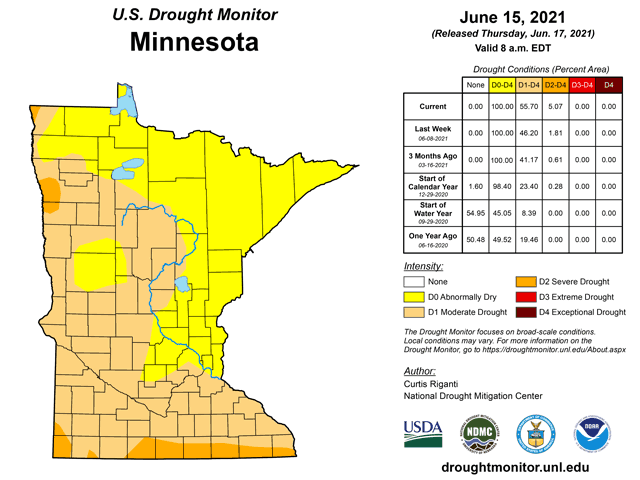Farmers Face Expanding Drought in Minn.
Minnesota Irrigators Warned of Potential Surface Water Restrictions
LINCOLN, Neb. (DTN) -- It last rained in Waverly, Minnesota, on May 27, and farmer Dan Glessing is watching his crops nervously, hoping for a break.
The latest drought monitor shows expansion of moderate and severe drought in areas of central and southern Minnesota. In southern Minnesota in particular, the number of counties in severe drought jumped from parts of five counties on June 8 to parts of nine counties one week later (https://droughtmonitor.unl.edu/…).
Glessing, who grows dairy and beef cattle, as well as corn, soybeans and alfalfa in south-central Minnesota, said that without rain in the coming days, his crop faces significant yield losses ahead.
"Some of our areas of our field are going to be compromised by my guess is 20% yield loss," he said. "Other areas are OK yet, but we do need it to rain soon. As far as drying us out, the extreme heat and low dew points, that really took a toll on the crop. Up until the 27th (of May), we were getting decent showers. But since then, it really put the nail in the coffin."
Currently, the corn crop has entered canopy stage on Glessing's farm. So far, his farm has received about 8.5 inches of moisture, down from the average of 15 inches.
Kevin Paap, a fourth-generation farmer in Blue Earth County in southern Minnesota, said drought is virtually unheard of on his farm, which is currently in moderate drought.
"I typically have crop stress from too much water, not too little," he said.
"June has averaged 14% warmer and six-tenths inch dryer than 1988. First 15 days in June have been the driest since 1893 and the second hottest since 1893."
The 1988 drought in Minnesota was the worst on record.
WATER USERS NOTIFIED
With drought conditions worsening in Minnesota, the state has notified water users, including irrigators, that surface water use restrictions may be coming. There are a little more than a half-million irrigated acres in the state.
P[L1] D[0x0] M[300x250] OOP[F] ADUNIT[] T[]
The Minnesota Department of Natural Resources sent out emails to water users this week, as drought continues to expand in the state.
"In 2021, we have seen abnormally dry conditions to moderate drought conditions since early spring in many parts of the state," MDNR said in emails to irrigators.
"If dry conditions persist in specific areas of the state, the DNR might need to begin discussing water-use restrictions with surface water appropriators in these counties. In the meantime, we are asking you to be extra vigilant with your water efficiency and to be observant of your neighbors' drinking water supplies."
Tom Hovey, water regulation unit supervisor at the Minnesota DNR, told DTN the state has surface water suspension guidelines for water users including irrigators.
"When the flows in a watershed reach a threshold (Q90 flows), we look into suspending authorization for surface water use in order to maintain sufficient water in the channel for in-stream use," he said.
A few counties have hit that threshold, including all of Wadena County and parts of Hubbard and Cass counties west of the Minneapolis metro area, according to MDNR.
RAIN CHANCES HIT AND MISS
DTN Meteorologist John Baranick said that although parts of the state have received some rainfall, including the very thirsty southern counties, the state remains dry.
Baranick said a better chance for rain comes with a system moving through on Sunday into Monday.
"Models are producing widespread rainfall across the state, but also with a scattered look to the storms," he said.
"There could be some areas that are missed. And with the system moving rather rapidly across the state, rainfall amounts are more likely to be on the lighter end, around 0.50 inch to 1 inch, though there could be some lucky folks that pick up more than that."
Baranick said temperatures are expected to fall next week with some below-normal readings expected.
"Beyond that, we might have to wait another week for a shot at some passing showers and thunderstorms, though there is plenty of uncertainty with regard to precipitation chances in the models beyond this weekend's storm," he said.
"Dryness has been in and around Minnesota all season long," he said.
"Parts of the state have been able to delay drought with rounds of rainfall, but the heat and dryness that has been constant thus far in June has finally broken most areas that have been able to avoid it."
Baranick said crop conditions have suffered with good-to-excellent ratings dropping 11 percentage points in corn and 12 percentage points in soybeans.
"Minneapolis has yet to record a temperature of 100, but it has gotten really close on several occasions," he said.
"As of June 15, the site has recorded 10 days above 90 degrees (Fahrenheit) this month, including nine straight. And this goes with only 0.40 inch of rainfall. That is almost 2 inches behind normal for this month. Similar conditions have been felt across the state. The combination has been brutal for soil moisture, just baking it out of the topsoils. Topsoil moisture has fallen to 36% adequate to surplus."
MDNR's Hovey said the state considers several factors when restricting water use, including the needs of navigation, fish and wildlife habitat, water-based recreation, drinking water supplies and priority of use.
Hovey said similar emails were sent to public water supply and hydroelectric power generation facilities.
Based on survey responses from about 500 irrigators in 2020, the state said in the email there are several issues irrigators should watch in conserving water.
That includes leak detection and repair, off-peak irrigating, testing sprinkler application rates and uniformity, regular scouting crops for moisture, soil testing for water-holding capacity and others.
Todd Neeley can be reached at todd.neeley@dtn.com
Follow him on Twitter @DTNeeley
(c) Copyright 2021 DTN, LLC. All rights reserved.




